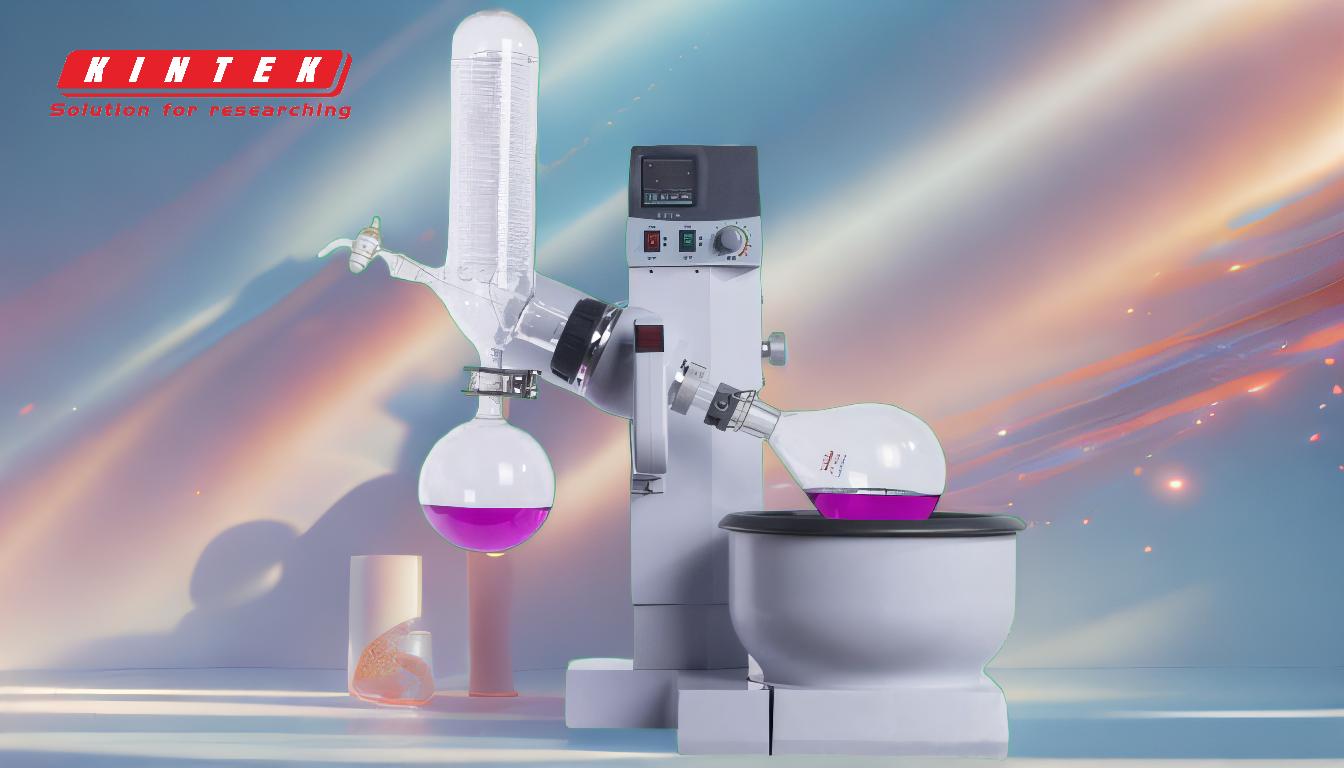A rotary evaporator, often referred to as a "rotovap," is a laboratory device used to efficiently and gently remove solvents from samples through evaporation. It operates by rotating a flask under vacuum conditions, which lowers the boiling point of the solvent, allowing it to evaporate at lower temperatures. The solvent vapor is then condensed and collected, leaving behind the desired sample. This process is widely used in chemistry, pharmaceuticals, and food science for tasks such as solvent recovery, concentration, and purification.
Key Points Explained:

-
Basic Working Principle:
- A rotary evaporator works by reducing the pressure inside the system, which lowers the boiling point of the solvent. This allows the solvent to evaporate at a lower temperature, minimizing the risk of thermal degradation of the sample.
- The evaporation flask is rotated to increase the surface area of the liquid, forming a thin film on the inner wall of the flask. This enhances the evaporation process.
-
Components and Their Functions:
- Evaporation Flask: Holds the sample and solvent. It rotates to increase the evaporation surface area.
- Water or Oil Bath: Provides uniform heating to the flask, ensuring controlled evaporation.
- Vacuum System: Reduces the pressure inside the system, lowering the boiling point of the solvent.
- Condenser: Cools the solvent vapor, converting it back into liquid form for collection.
- Receiving Flask: Collects the condensed solvent after it passes through the condenser.
-
Operational Steps:
- Setup: Place the sample in the evaporation flask and secure it to the rotary evaporator. Attach the receiving flask to collect the condensed solvent.
- Rotation: Start rotating the flask at a suitable speed (typically between 50 to 160 revolutions per minute) to create a thin film of the sample on the flask's inner wall.
- Vacuum Application: Gradually apply vacuum to the system. The pressure is usually maintained between 400 to 600 mm Hg.
- Heating: Turn on the water or oil bath to provide heat. The temperature should be set according to the solvent's boiling point under reduced pressure.
- Evaporation and Condensation: As the flask rotates and heats, the solvent evaporates, forms a vapor, and then condenses in the condenser. The condensed solvent is collected in the receiving flask.
- Completion: Once all the solvent has evaporated, stop the rotation and release the vacuum. Remove the flask containing the concentrated sample.
-
Advantages of Using a Rotary Evaporator:
- Efficiency: The combination of rotation, vacuum, and heating significantly speeds up the evaporation process.
- Gentle Evaporation: By lowering the boiling point, the rotary evaporator minimizes the risk of damaging heat-sensitive samples.
- Solvent Recovery: The condensed solvent can be collected and reused, making the process cost-effective and environmentally friendly.
-
Key Considerations for Operation:
- Rotation Speed: The speed should be adjusted based on the volume and viscosity of the sample. Too high a speed can cause splashing, while too low a speed may not form an adequate film for evaporation.
- Vacuum Control: The vacuum level must be carefully controlled to ensure efficient evaporation without causing the sample to boil too vigorously.
- Temperature Regulation: The heating bath temperature should be set according to the solvent's boiling point under the applied vacuum to avoid overheating the sample.
-
Applications:
- Chemistry: Used for solvent removal, concentration of reaction mixtures, and purification of compounds.
- Pharmaceuticals: Essential for drug formulation and purification processes.
- Food Science: Employed in the extraction and concentration of flavors, fragrances, and essential oils.
In summary, a rotary evaporator is a versatile and efficient tool for solvent removal and sample concentration. Its operation relies on the principles of reduced pressure, controlled heating, and increased surface area through rotation, making it an indispensable device in various scientific fields.
Summary Table:
| Component | Function |
|---|---|
| Evaporation Flask | Holds the sample and solvent; rotates to increase evaporation surface area. |
| Water/Oil Bath | Provides uniform heating for controlled evaporation. |
| Vacuum System | Reduces pressure, lowering the solvent's boiling point. |
| Condenser | Cools solvent vapor, converting it back to liquid for collection. |
| Receiving Flask | Collects the condensed solvent after evaporation. |
Discover how a rotary evaporator can streamline your lab processes—contact us today!











